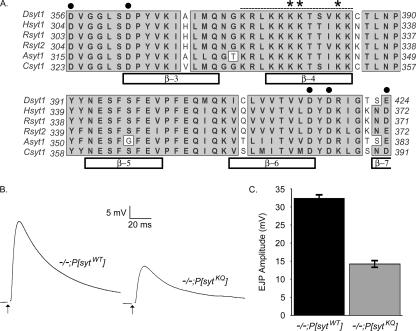Figure 1.
Synaptotagmin C2B polylysine region is highly conserved throughout evolution and is required for efficient synaptic transmission. (A) ClustalW sequence alignment of 56 highly conserved amino acids from the C2B domain of synaptotagmin. Bars indicate β-sheets within the C2B domain. Circles mark the Ca2+-binding motif. Dotted line denotes the polybasic region. Asterisks mark the polylysine motif. (B) Representative traces showing evoked release during 0.05-Hz stimulation in HL3 saline containing 1.5 mM Ca2+ in transgenic controls (−/−;P[sytWT]) and polylysine motif mutants (−/−;P[sytKQ]). Each trace is an average of 10–12 individual traces from a single muscle fiber. Stimulus artifact has been removed for clarity. (C) The mean EJP amplitude in saline containing 1.5 mM Ca2+ was 14.2 ± 0.82 mV (mean ± SEM; n = 34 fibers) for polylysine motif mutants and 32.4 ± 0.99 mV (mean ± SEM; n = 42 fibers) for transgenic wild-type controls (p ≪ 0.001).

